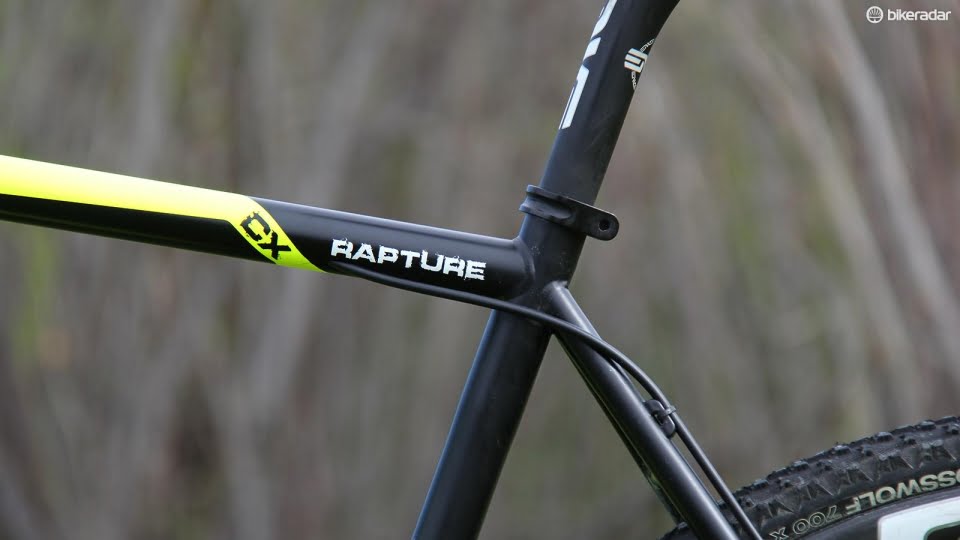The Rapture’s handling is best described as neutral. Even when leaned hard into corners there’s never a sense of oversteer. The bottom bracket is low enough to make it feel carvy without being slammed to the point of catching pedals when spinning through off-camber sections.
The 4130 chromoly steel frame doesn’t ride as sprightly as high-end steel tubesets do, but it does a commendable job of smoothing out rough courses.
Transition chose to route the rear brake line internally through the top tube, so there’s no cable in the way when grabbing the tube or shouldering the bike.

Internal routing for the rear brake line
The cables for the front and rear derailleurs are routed externally along the down tube. These cable stops can be removed as needed for a 1x drivetrain or when setting the Rapture up as a singlespeed.

Since I was running a 1x drivetrain, I only needed one cable stop on the down tube
While we’re on the subject of singelspeeds, the Rapture uses rocker-style dropouts to tension the chain. I prefer this system to the trackends used on several other popular singlespeed ’cross bikes, because it allows for quick wheel changes and ensures the rear wheel, as well as the rotor, is always properly aligned in the frame.

The Rapture’s dropouts are simple and effective
Budget-minded but big-boned

Even with a high-end build kit, the Rapture is still no flyweight
Transition provided a high-end build kit for our Rapture frameset. The drivetrain and brakes consisted of SRAM’s Force CX1 group while Enve’s light and stiff XC wheels and tubeless-ready WTB Crosswolf rubber kept me rolling. Enve rounded out the build with a carbon stem, handlebar and seatpost. This was about as top-shelf as one can get, and would set a rider back about US$5,000. Even with all this fancy kit bolted to it, the Rapture was far from the lightest bike toeing the start line, with a complete weight of 8.3kg / 18.3lb.
When compared with today’s lightweight carbon wunderbikes, or even to custom steel ’cross bikes, the Rapture is a bit hefty. The frame weighs 2.1kg / 4.56lb. Add the 1kg / 2.3lb matching steel fork and you’ve got a frameset that tips the scales at 3.1kg / 6.86lb.
While it may be twice the weight of some top-end framesets, though, it’s less than half the cost. That seems like a fair tradeoff to me.
Riders looking to cut weight can always build the Rapture up as a singlespeed. Swapping the 1 1/8in steel fork for a carbon version with a tapered steerer is also an option, thanks to the bike’s 44mm head tube.

A 44mm head tube gives the Rapture a bit of versatility when it comes to aftermarket fork options
Last but not least, the fact that the Rapture sticks with a 68mm threaded bottom bracket shell, 135mm rear axle spacing, and quick-release axles at both ends means it can easily be built up with components that might be collecting dust in your home workshop thanks to the cycling industry’s relentless need for technological change.
[“source-bikeradar”]
